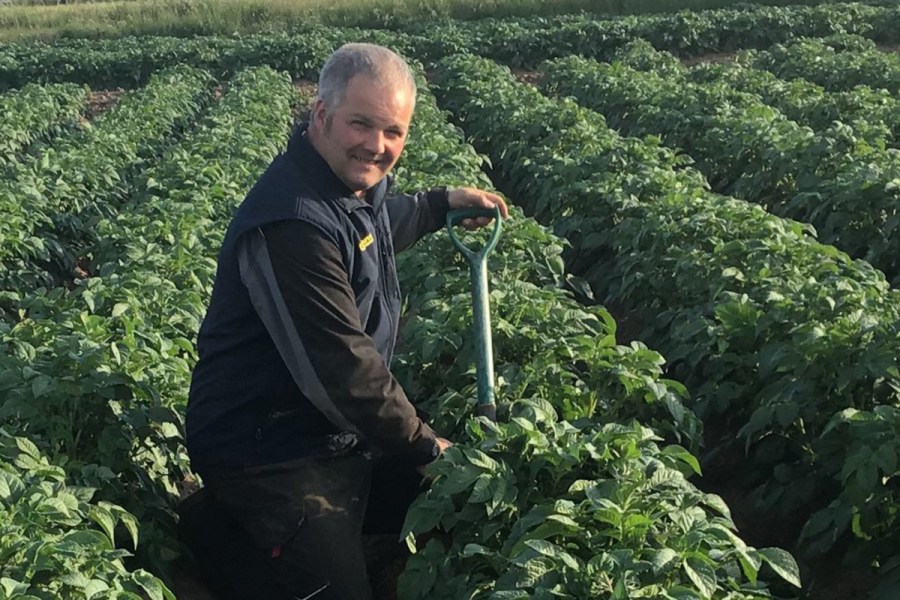 By Andrew Wilson
By Andrew Wilson
Certainly the calculator is out! We’ve just come through some of the hottest temperatures that I have experienced in my 25 years of full-time farming (by the time I was born in November 1976 it was raining!). Crops have had a kicking, even up here in North Yorkshire.
Beet is remarkably resilient. We can’t get water to this year’s crops (does it pay anyway?). All our conventional beet was mostly flat on the floor in the heat, but the Conviso beet has stood the pain a little better. We got some salt on in perfect conditions, and since the recent rain, have been over with some biological foliar feed to perk it up a bit. It’ll be ok, but there won’t be many yield records broken this year.
Winter beans have accelerated into senescence in the hot dry weather, though still probably a good month off fit. Spring beans are showing us where the light patches are in fields and won’t amount to anything special this time. If beans do nothing else though, they give us a superb entry into a first wheat with comparatively low costs and at low risk. We will continue to direct drill them, perhaps with some placed biological root promoter under them, as we will with some other crops.
Winter barley has done well this time, with an average yield over the weighbridge just scraping 9t/ha at 13%, with plenty of straw. Prices are reasonable, it’s a good start to harvest and helps cashflow. Winter barley’s Achilles heel for us now is that it’s not a great choice for strip-till establishment as a second cereal after wheat. Some will remain but will slip into a third cereal position on light land, with spring barley preceded by wheat on light land.
Our spring barley and spring oats are nothing special, largely down to being a bit later than ideally sown, and the subsequent dry weather. Fortunately, there isn’t a huge area of either this time. The stubbornly low milling oat price has encouraged me to grow some oilseed rape for the 2023 harvest, a crop we haven’t grown here since 2010. The fields lined up for are the dirtiest we have presently as far as grassweeds are concerned, and both are due for muck this summer. The toe is in the water!
Wheat is a bit of a mixed bag to walk, but overall decent. Heavy land looks like it will be the winner this time, but with no wheat cut up here yet, we may see a few surprises.
So where does that leave potatoes? Stressed! Some crops are ready for MH, but even those we can irrigate are not in good enough condition at the time of writing to consider application. Sprout control in store this winter could (will) be challenging. Where we can water, we are doing but that is about at a standstill now. Crop potential is well below target currently but at least blight pressure is low!
As ever, those crops with the best rooting are showing the best resilience, with good response again to in furrow biological products over chemical ones in trials.
I’ve mentioned before that I feel that there is a correlation between the physiological age of the daughter crop and dormancy break. From an MH point of view, the label recommendation of 3-5 weeks from burn off is somewhat 1990s language. In a hot year like this, we’ve seen dormancy break in July in a crop that won’t be burnt off until early October, which is ten weeks away yet. I’m no scientist, and haven’t yet calculated a trigger point, but we don’t see dormancy break anything like as early as this in cool seasons. Numbers of sprouted tubers are very low so far but can be found, which is a concern.
Call me old fashioned but I highly value simplicity, reliability, and accuracy when it comes to technology in farming. The good old Smart test (from the Reglone days) is, I find, a very good guide as to whether there is sufficient moisture to apply MH. Day degrees are not difficult to calculate either. There are many sophisticated models out there to ‘assist’ us – most of which by my observation make money for manufacturer, supplier, installer, and supporter, but seldom for the farmer. For cost, we must have in return value – good, practical data to assist decision making.
I said last month that communication from our market was minimal, and nothing has changed. Potatoes have built our business, but I’ll be damned if I’m going to watch them take it away. This season is reminiscent of 2018, which (financially) was one I’d rather forget – suffice to say motivation for potato related investment isn’t high at the moment.
As contract processing growers, we accept that we have no control of prices, (in or out) and carry a far greater level of risk than any other section of the food chain. Our only real control is ‘Yes or No’ – the latter is becoming the more attractive option. My gut feel at present is that our area will drop by at least a third next season to reduce some risk exposure – and I know I’m not alone with this.
The UK potato scene is desperate. Numbers of potato growers are plummeting. Never before have I felt so disheartened and unvalued by our ever-demanding customers, who seem pretty oblivious to the whole situation on the ground.
I’m a lifetime passionate potato grower – I love being a part of this (once) great industry, but my appetite for working 400hrs a month and carrying all the risk for such scant reward is dwindling fast – there are easier options out there.
Happy harvesting (and crystal ball gazing).
This article was taken from the latest issue of CPM. For more articles like this, subscribe here.




